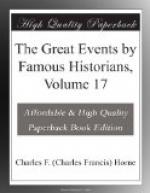After the comparative failure of the gold-diggings in South Australia, the Government had wisely set itself to secure some part of the prosperity of the gold discoveries for its colony by establishing both land and river traffic routes. In these efforts it was highly successful. Many South Australians made handsome fortunes by sending provisions to the Buninyong and Mount Alexander districts, and the new steamers on the Murray proved a source of profit to the colony which lasted until the development of the railroad system. Unfortunately, this prosperity could hardly be realized at the time, owing to the great scarcity of coined money in the colony. In 1851 the privilege of coining was still jealously monopolized by the mint in London; while the rapid expansion of business in the latter part of that year had rendered the supply of coin in Australia totally inadequate to the demand.
Very soon after the discoveries, Governor Fitzroy had sent home a memorial from the Legislative Council at Sydney, praying for the establishment of a branch mint in that city, and similar applications soon followed from the other colonies. On March 22, 1853, a Treasury minute sanctioned the applications, and colonial mints were shortly afterward established by order in council. But in the mean while the South Australians had got over their difficulty by passing a colonial act authorizing the issue by the Colonial Government of gold ingots, of slightly higher intrinsic value than the coins they were supposed to represent, stamped with an authentic mark. These ingots were not made legal tender, and the only object of the government mark was to guarantee quality and weight. But they were generally accepted in official and commercial transactions, they tided over the crisis of scarcity, and the Home Government, though with due official caution, approved the action of Governor Young.
In Tasmania, the main difficulty arose from the drain of emigrants. In August, 1851, Sir William Denison wrote home urging the transportation of more convicts or “probationers,” on the ground that there would be a great demand for foodstuffs by the neighboring colonies, while the supply of agricultural laborers would be shorter than ever. Both Tasmania and South Australia united in deciding upon the continuance of the system by which free emigrants were sent out at the expense of the land fund of each colony, notwithstanding that such emigrants would probably leave for Victoria immediately after their arrival. Of the existence of this contingency there could be little doubt. On January 16, 1852, the Governor of Tasmania wrote: “I have a number of men who have come back from Mount Alexander after an absence from this colony of not more than eight weeks, with gold to the value of one hundred twenty pounds to one thousand pounds.” During the five months which followed the writing of this letter, four thousand persons (most of them wage-earners in the prime of life) left Tasmania for Victoria. As the whole population of Tasmania was at this time only about fifty thousand, the matter was serious. Nevertheless, Tasmania tided safely over the difficulties of the gold period, and even was able to help her sorely tried sister.




